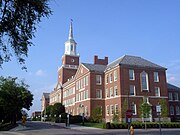Cincinnati metropolitan area
Greater Cincinnati Cincinnati, OH–KY–IN Metropolitan Statistical Area | |
|---|---|
 | |
 | |
| Country | |
| State | |
| Largest city | |
| Counties | |
| Area | |
• Total | 4,808 sq mi (12,450 km2) |
| Elevation | 551 ft (168 m) |
| Population (2015)[2] | |
| • Metro density | 469/sq mi (181/km2) |
| • MSA | 2,256,884 (28th)[1] |
| MSA/CSA = 2015, Urban = 2013 | |
| GDP | |
| • MSA | $186.1 billion (2022) |
| Time zone | UTC−5 (EST) |
| • Summer (DST) | UTC−4 (EDT) |
| Area code(s) | 513, 283, 859, 937, 812 |
The Cincinnati metropolitan area (also known as the Cincinnati Tri-State area or Greater Cincinnati) is a metropolitan area with its core in Ohio and Kentucky.[4][5] Its largest city is Cincinnati and includes surrounding counties in the U.S. states of Ohio, Kentucky, and Indiana.
The United States Census Bureau's formal name for the area is the Cincinnati, OH–KY–IN Metropolitan Statistical Area. As of the 2020 U.S. Census, the metro area had a population of 2,256,884, making Greater Cincinnati the 28th-most populous metropolitan area in the United States, and the largest metro area in Ohio, followed by Columbus and Cleveland.[6] The Cincinnati–Wilmington, OH–KY–IN Combined Statistical Area, adds Clinton County, Ohio (defined as the Wilmington, OH micropolitan area) and, until 2023, Mason County, Kentucky (defined as the Maysville, KY micropolitan area), was part of the CSA.[7] The Cincinnati metropolitan area is considered part of the Great Lakes Megalopolis.
Census designation history
The Cincinnati metropolitan area was originally designated by the United States Census Bureau in 1950 and consisted of the Kentucky counties of Campbell and Kenton and the Ohio county of Hamilton. As surrounding counties saw an increase in their population densities and the number of their residents employed within Hamilton County, they met Census criteria to be added to the MSA. The Hamilton–Middletown, OH MSA was also formed in 1950 and consisted solely of Butler County, Ohio.
In 1990, the Census changed designation of the areas known as MSAs to Primary Metropolitan Statistical Area (PMSA), and a new Consolidated Metropolitan Statistical Area (CMSA) grouping was created. From 1990 through 2005, the Cincinnati–Hamilton–Middletown CMSA included the Cincinnati–Hamilton, OH–KY–IN PMSA and the Hamilton–Middletown, OH PMSA.
As of December 2005, Census terminology changed again, eliminating the PMSA/CMSA terminology. Consolidated Statistical Areas (CSA) combine more than one Core Based Statistical Area (CBSA). Newly defined MSAs (Metropolitan) and μSAs (Micropolitan) Statistical Areas are CBSAs. From 2005 to 2013, the Cincinnati–Middletown–Wilmington CSA included the Cincinnati–Middletown MSA (defined as the old Cincinnati–Hamilton–Middletown CMSA), and Wilmington, OH μSA (Clinton County, Ohio).
In 2013, the CSA was redefined again. The Cincinnati–Middletown MSA was renamed the Cincinnati MSA. The Wilmington, OH μSA remained in the CSA. The Maysville, KY μSA, which had previously consisted of Mason and Lewis Counties in Kentucky, was redefined as consisting solely of Mason County and added to the CSA. The name of the CSA accordingly changed to the Cincinnati–Wilmington–Maysville CSA.
In September 2018, Union County, Indiana, was added to the Cincinnati MSA.[8]
In July 2023, the new metropolitan area delineation were published and Union County, Indiana, was detached from the Cincinnati MSA, and the Maysville, Kentucky, micropolitan statistical area was detached from the combined statistical area.[9]
Most of the region's population growth has occurred in the northern counties, leading to speculation that the Cincinnati–Northern Kentucky metropolitan area will eventually merge with Greater Dayton.[10] Cincinnati is also located very close to other metropolitan areas, such as Columbus, Indianapolis, Lexington, and Louisville.
Population
| Census | Pop. | Note | %± |
|---|---|---|---|
| 1950 | 1,244,738 | — | |
| 1960 | 1,544,659 | 24.1% | |
| 1970 | 1,690,234 | 9.4% | |
| 1980 | 1,753,801 | 3.8% | |
| 1990 | 1,844,917 | 5.2% | |
| 2000 | 2,009,632 | 8.9% | |
| 2010 | 2,130,151 | 6.0% | |
| 2020 | 2,256,884 | 5.9% | |
| data source:[11] | |||
| Statistical Area/County | 2020 Census | 2010 Census | 2000 Census | 1990 Census | 1980 Census | 1970 Census | 1960 Census | 1950 Census |
|---|---|---|---|---|---|---|---|---|
| Cincinnati–Wilmington–Maysville, OH-KY-IN CSA | 2,316,022 | 2,172,191 | 2,050,175 | 1,880,332 | 1,788,404 | 1,721,698 | 1,574,663 | 1,270,310 |
| Cincinnati, OH-KY-IN MSA | 2,256,884[12] | 2,130,151 | 2,009,632 | 1,844,917 | 1,753,801 | 1,690,234 | 1,544,659 | 1,244,738 |
| Hamilton County, Ohio | 830,639 | 802,374 | 845,303 | 866,228 | 873,224 | 924,018 | 864,121 | 723,952 |
| Butler County, Ohio2 | 390,357 | 368,130 | 332,807 | 291,479 | 258,787 | 226,207 | 199,076 | 147,203 |
| Warren County, Ohio | 242,337 | 212,693 | 158,383 | 113,909 | 99,276 | 84,925 | 65,711 | 38,505 |
| Clermont County, Ohio | 208,601 | 197,363 | 177,977 | 150,187 | 128,483 | 95,725 | 80,530 | 42,182 |
| Brown County, Ohio | 43,676 | 44,846 | 42,285 | 34,966 | 31,920 | 26,635 | 25,178 | 22,221 |
| Clinton County, Ohio | 42,018 | |||||||
| Boone County, Kentucky | 135,968 | 118,811 | 85,991 | 57,589 | 45,842 | 32,812 | 21,940 | 13,015 |
| Kenton County, Kentucky | 169,064 | 159,720 | 151,464 | 142,031 | 137,058 | 129,440 | 120,700 | 104,254 |
| Campbell County, Kentucky | 93,076 | 90,336 | 88,616 | 83,866 | 83,317 | 88,501 | 86,803 | 76,196 |
| Grant County, Kentucky | 24,941 | 24,662 | 22,384 | 15,737 | 13,308 | 9,999 | 9,489 | 9,809 |
| Pendleton County, Kentucky | 14,644 | 14,877 | 14,390 | 12,036 | 10,989 | 9,949 | 9,968 | 9,610 |
| Bracken County, Kentucky | 8,400 | 8,488 | 8,279 | 7,766 | 7,738 | 7,227 | 7,422 | 8,424 |
| Gallatin County, Kentucky | 8,690 | 8,589 | 7,870 | 5,393 | 4,842 | 4,134 | 3,867 | 3,969 |
| Mason County, Kentucky | 17,120 | |||||||
| Dearborn County, Indiana | 50,679 | 50,047 | 46,109 | 38,835 | 34,291 | 29,430 | 28,674 | 25,141 |
| Franklin County, Indiana | 22,785 | 23,087 | 22,151 | 19,580 | 19,612 | 16,943 | 17,015 | 16,034 |
| Ohio County, Indiana | 5,940 | 6,128 | 5,623 | 5,315 | 5,114 | 4,289 | 4,165 | 4,223 |
| Union County, Indiana | 7,087 |
Notes
1For comparison purposes, population data is summarized using 2008 Census CSA/MSA county definitions.
2Butler County, Ohio was previously known as the Hamilton–Middletown, OH PMSA and was separate from the Cincinnati, OH–KY–IN PMSA until the 1990 Census, when the Cincinnati–Hamilton, OH–KY–IN CMSA designation was used to consolidate the two PMSAs. The CMSA/PMSA designation is no longer used by the US Census.
Main cities

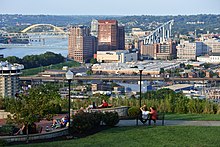
Population figures as of the 2020 census.
Municipalities with more than 100,000 inhabitants
- Cincinnati, Ohio (309,317)
Municipalities with 50,000 to 99,999 inhabitants
- Hamilton, Ohio (63,399)
- Middletown, Ohio (50,987)
Municipalities with 10,000 to 49,999 inhabitants
- Fairfield, Ohio (42,623)
- Covington, Kentucky (40,961)
- Mason, Ohio (40,691 )
- Florence, Kentucky (31,946)
- Independence, Kentucky (28,676)
- Oxford, Ohio (23,035)
- Lebanon, Ohio (20,841)
- Forest Park, Ohio (20,189)
- Erlanger, Kentucky (19,611)
- Springboro, Ohio (19,062)
- Norwood, Ohio (19,043)
- Fort Thomas, Kentucky (17,438)
- Newport, Kentucky (14,150)
- Sharonville, Ohio (14,117)
- Blue Ash, Ohio (13,394)
- Loveland, Ohio (13,307)
- Wilmington, Ohio (12,660) (CSA)
- Springdale, Ohio (11,007)
- Reading, Ohio (10,600)
- Alexandria, Kentucky (10,341)
Climate
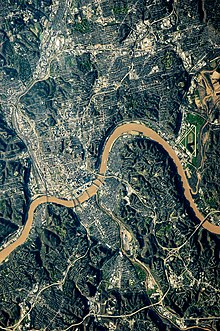
The Cincinnati–Northern Kentucky metropolitan area is located within a climatic transition zone. The southern area of the region, from roughly about the Ohio River, is at the extreme northern limit of the humid subtropical climate; the north part of the region is on the extreme southern cusp of the humid continental climate. Evidence of both humid subtropical climate and humid continental climate can be found here, particularly noticeable by the presence of plants indicative of each climatic region. Within the area, the USDA climate zone rating can vary from as warm as zone 6b[13] to as cool as zone 5b,[14] with the warmest areas tending to be found closest to the Ohio River; individual microclimates of even cooler and warmer temperature may occur in the area but are too small to be considered in the overall climate zone rating. The common wall lizard, introduced from Italy in the 1950s, is an example of fauna in the area that lends a subtropical ambiance to the urban core (near downtown Cincinnati) area of the region.
Significant moderating variables for the overall climate are:
- South and central: Ohio River, Licking River, relatively large hills and valleys, and a combined urban heat island effect due to the close proximity of the Cincinnati-Northern Kentucky cities of Covington, Newport, and Downtown Cincinnati
- Suburban: large parking lots that take up much land in Mason, West Chester, and Florence create a heat island effect.
- North: Great Miami River, the area is situated on a glaciated flat plateau, the Miami Valley, and some urban heat island effect in the immediate area of downtown Dayton and Hamilton.
Traveling through the region from North to South, a subtle but interesting change in climate can be observed and is most evidenced by the gradual increase in the occurrence of subtropical indicator plants in the landscape. Most noticeable are the Southern Magnolia and Mimosa trees, and the needle palm also may be found as a winter hardy landscape specimen in lawns near the Ohio River. During the winter, travellers from north to south will routinely observe a significant difference in snowfall/ice/rain in the region.
Although widely accepted as part of the very southern fringe of the Midwestern United States in most cases, the Cincinnati–Northern Kentucky metropolitan area is climatically and geographically located on the northern periphery of the Upland South region of the United States and is within the Bluegrass region of Ohio and Kentucky in the Upper South.
The area is vulnerable to occasional severe weather—thunderstorms, large hail and sometimes tornadoes.
| Climate data for Cincinnati (Cincinnati/Northern Kentucky Int'l), 1991–2020 normals,[a] extremes 1871–present[b] | |||||||||||||
|---|---|---|---|---|---|---|---|---|---|---|---|---|---|
| Month | Jan | Feb | Mar | Apr | May | Jun | Jul | Aug | Sep | Oct | Nov | Dec | Year |
| Record high °F (°C) | 77 (25) |
79 (26) |
88 (31) |
90 (32) |
95 (35) |
102 (39) |
108 (42) |
103 (39) |
102 (39) |
95 (35) |
82 (28) |
75 (24) |
108 (42) |
| Mean maximum °F (°C) | 61.8 (16.6) |
66.1 (18.9) |
74.3 (23.5) |
81.1 (27.3) |
86.7 (30.4) |
91.6 (33.1) |
93.6 (34.2) |
93.2 (34.0) |
90.7 (32.6) |
82.9 (28.3) |
72.0 (22.2) |
63.8 (17.7) |
95.3 (35.2) |
| Mean daily maximum °F (°C) | 39.6 (4.2) |
43.7 (6.5) |
53.5 (11.9) |
65.5 (18.6) |
74.5 (23.6) |
82.6 (28.1) |
86.0 (30.0) |
85.2 (29.6) |
78.9 (26.1) |
66.7 (19.3) |
53.8 (12.1) |
43.3 (6.3) |
64.4 (18.0) |
| Daily mean °F (°C) | 31.4 (−0.3) |
34.7 (1.5) |
43.6 (6.4) |
54.6 (12.6) |
64.1 (17.8) |
72.3 (22.4) |
75.9 (24.4) |
74.9 (23.8) |
68.1 (20.1) |
56.2 (13.4) |
44.4 (6.9) |
35.6 (2.0) |
54.7 (12.6) |
| Mean daily minimum °F (°C) | 23.1 (−4.9) |
25.8 (−3.4) |
33.8 (1.0) |
43.7 (6.5) |
53.7 (12.1) |
62.1 (16.7) |
65.9 (18.8) |
64.6 (18.1) |
57.3 (14.1) |
45.7 (7.6) |
35.1 (1.7) |
27.9 (−2.3) |
44.9 (7.2) |
| Mean minimum °F (°C) | 0.1 (−17.7) |
6.5 (−14.2) |
14.8 (−9.6) |
26.7 (−2.9) |
36.6 (2.6) |
49.2 (9.6) |
55.9 (13.3) |
54.6 (12.6) |
42.5 (5.8) |
29.8 (−1.2) |
19.0 (−7.2) |
9.1 (−12.7) |
−2.7 (−19.3) |
| Record low °F (°C) | −25 (−32) |
−17 (−27) |
−11 (−24) |
15 (−9) |
27 (−3) |
39 (4) |
47 (8) |
43 (6) |
31 (−1) |
16 (−9) |
0 (−18) |
−20 (−29) |
−25 (−32) |
| Average precipitation inches (mm) | 3.30 (84) |
3.17 (81) |
4.16 (106) |
4.53 (115) |
4.67 (119) |
4.75 (121) |
3.83 (97) |
3.43 (87) |
3.11 (79) |
3.35 (85) |
3.23 (82) |
3.73 (95) |
45.26 (1,150) |
| Average snowfall inches (cm) | 7.7 (20) |
6.7 (17) |
3.4 (8.6) |
0.4 (1.0) |
0.0 (0.0) |
0.0 (0.0) |
0.0 (0.0) |
0.0 (0.0) |
0.0 (0.0) |
0.2 (0.51) |
0.8 (2.0) |
4.1 (10) |
23.3 (59) |
| Average extreme snow depth inches (cm) | 3.5 (8.9) |
3.4 (8.6) |
2.0 (5.1) |
0.2 (0.51) |
0.0 (0.0) |
0.0 (0.0) |
0.0 (0.0) |
0.0 (0.0) |
0.0 (0.0) |
0.1 (0.25) |
0.4 (1.0) |
2.0 (5.1) |
6.0 (15) |
| Average precipitation days (≥ 0.01 in) | 13.2 | 12.0 | 12.5 | 13.1 | 13.5 | 11.8 | 11.0 | 8.9 | 8.3 | 8.7 | 10.3 | 12.4 | 135.7 |
| Average snowy days (≥ 0.1 in) | 6.7 | 5.9 | 2.7 | 0.6 | 0.0 | 0.0 | 0.0 | 0.0 | 0.0 | 0.1 | 1.1 | 4.6 | 21.7 |
| Average relative humidity (%) | 72.2 | 70.1 | 67.0 | 62.8 | 66.9 | 69.2 | 71.5 | 72.3 | 72.7 | 69.2 | 71.0 | 73.8 | 69.9 |
| Average dew point °F (°C) | 19.9 (−6.7) |
22.5 (−5.3) |
31.3 (−0.4) |
39.6 (4.2) |
50.5 (10.3) |
59.7 (15.4) |
64.2 (17.9) |
63.0 (17.2) |
56.7 (13.7) |
43.7 (6.5) |
34.7 (1.5) |
25.5 (−3.6) |
42.6 (5.9) |
| Mean monthly sunshine hours | 120.8 | 128.4 | 170.1 | 211.0 | 249.9 | 275.5 | 277.0 | 261.5 | 234.4 | 188.8 | 118.7 | 99.3 | 2,335.4 |
| Percent possible sunshine | 40 | 43 | 46 | 53 | 56 | 62 | 61 | 62 | 63 | 55 | 39 | 34 | 52 |
| Average ultraviolet index | 2 | 3 | 5 | 6 | 8 | 9 | 9 | 8 | 7 | 4 | 2 | 2 | 5 |
| Source 1: NOAA (relative humidity and sun 1961–1990)[15][16][17][18] | |||||||||||||
| Source 2: Weather Atlas (UV)[19] | |||||||||||||
Transportation
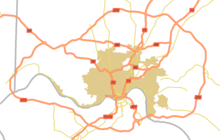
Public transportation
The Connector streetcar line opened in Cincinnati in 2016.[20][21] Amtrak's Cardinal makes three weekly trips in each direction between Chicago and New York City through Cincinnati Union Terminal. Regional transit authorities serving the area include the Southwest Ohio Regional Transit Authority (SORTA), the Transit Authority of Northern Kentucky (TANK) and the Clermont Transportation Connection. SORTA and TANK primarily operate 40-foot (12 m) diesel buses, though some lines are served by longer articulated or hybrid-engine buses.
Air
The Cincinnati area is served by Cincinnati/Northern Kentucky International Airport (CVG) in Hebron, Kentucky. The airport is one of DHL Aviation's three superhubs, offering non-stop passenger service to over 50 destinations in North America and Europe.[22] The airport is a global hub for Amazon Air, Atlas Air, ABX Air, Kalitta Air, and DHL Aviation, handling numerous domestic and international cargo flights every day.[23] CVG is currently the 6th busiest airport in the United States by cargo traffic, and is additionally the fastest-growing cargo airport in North America.[24][25]
Roads
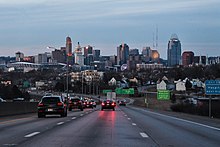
US Highways

 U.S. Route 22 & State Route 3 (Montgomery Road)
U.S. Route 22 & State Route 3 (Montgomery Road) U.S. Route 27 (Colerain Avenue)
U.S. Route 27 (Colerain Avenue) U.S. Route 42 (Reading Road, Lebanon Road)
U.S. Route 42 (Reading Road, Lebanon Road) U.S. Route 50 (Columbia Parkway, Ohio Pike)
U.S. Route 50 (Columbia Parkway, Ohio Pike) U.S. Route 52 (Riverside Drive, Kellogg Avenue)
U.S. Route 52 (Riverside Drive, Kellogg Avenue) U.S. Route 127 (Hamilton Avenue)
U.S. Route 127 (Hamilton Avenue)
Ohio State Highways
 Ohio State Route 4 (Springfield Pike, Dixie Highway)
Ohio State Route 4 (Springfield Pike, Dixie Highway) Ohio State Route 28
Ohio State Route 28 Ohio State Route 32
Ohio State Route 32 Ohio State Route 126 (Ronald Reagan Cross County Highway)
Ohio State Route 126 (Ronald Reagan Cross County Highway) Ohio State Route 129 (Butler County Veterans Highway)
Ohio State Route 129 (Butler County Veterans Highway) Ohio State Route 131
Ohio State Route 131 Ohio State Route 562 (Norwood Lateral)
Ohio State Route 562 (Norwood Lateral) Ohio State Route 747 (Princeton Pike)
Ohio State Route 747 (Princeton Pike)
Kentucky State Highways
 Kentucky Route 9 (AA Highway)
Kentucky Route 9 (AA Highway) Kentucky Route 17 (Madison Pike)
Kentucky Route 17 (Madison Pike) Kentucky Route 18 (Burlington Pike)
Kentucky Route 18 (Burlington Pike) Kentucky Route 177 (Decoursey Pike)
Kentucky Route 177 (Decoursey Pike)
Historic and notable roads
Education
Ohio
- University of Cincinnati
- Xavier University
- Cincinnati State Technical and Community College
- Miami University
- Mount St. Joseph University
- Union Institute & University
- Hebrew Union College
- Art Academy of Cincinnati
- God's Bible School and College
Kentucky
- Northern Kentucky University
- Thomas More University
- Gateway Community and Technical College
- Maysville Community and Technical College
Indiana
- University of Cincinnati
- Miami University
- Northern Kentucky University
- Art Academy of Cincinnati
Area codes
- 513 and 283 – Ohio counties and Cincinnati
- 937 and 326 – Ohio counties
- 859 – most Kentucky counties
- 606 – Bracken and Mason counties, Kentucky
- 812 and 930 – Indiana counties
- 765 – Indiana counties
In media
Cincinnati-based broadcast media outlets often use the terms "Greater Cincinnati" and "Tri-State Area" to refer to their broader viewing or listening areas, especially for the purpose of weather reports or school closings. The viewing areas of WLWT, WCPO-TV, and WKRC-TV all span the same 26 counties, including Adams and Highland counties in Ohio; Fayette, Ripley, Switzerland, and Union counties in Indiana; and Carroll, Owen, and Robertson counties in Kentucky.[26][27][28] WXIX-TV additionally includes Decatur County in Indiana and Lewis County in Kentucky.[29]
Dayton-area media outlets similarly refer to a Miami Valley area that includes Butler and Warren counties in Ohio and sometimes Clinton County, Ohio, and Union County, Indiana.
Notes
- ^ Mean monthly maxima and minima (i.e. the expected highest and lowest temperature readings at any point during the year or given month) calculated based on data at said location from 1991 to 2020.
- ^ Official records for Cincinnati kept at downtown from January 1871 to March 1915, at the Cincinnati Abbe Observatory just north of downtown from April 1915 to March 1947, and at KCVG near Hebron, Kentucky since April 1947. For more information, see Threadex and History of Weather Observations Cincinnati, Ohio 1789–1947.
References
- ^ "Census 2020: Cincy in a growth spurt; region gains 33 people every day".
- ^ "Greater Cincinnati Metro Region Resourcebook (Gallis Report)" (PDF). University of Cincinnati.
- ^ "Total Gross Domestic Product for Cincinnati, OH-KY-IN (MSA)". fred.stlouisfed.org.
- ^ "2020 Census Urban Areas of the United States and Puerto Rico" (PDF). US Census Bureau. Retrieved July 26, 2023.
- ^ "Federal Register/Vol. 75, No. 123/Monday, June 28, 2010/Notices" (PDF). US Census Bureau. Retrieved July 26, 2023.
- ^ Table of United States Metropolitan Statistical Areas
- ^ "Population Estimates". Retrieved February 11, 2016.
- ^ "OMB Bulletin No. 18-04" (PDF) (Press release). Office of Management and Budget. September 2018. p. 47.
- ^ "OMB Bulletin No. 23-01" (PDF) (Press release). Office of Management and Budget. July 2023.
- ^ "Ready for 'Daytonnati?' It could happen". Cincinnati.bizjournals.com. November 9, 1998. Retrieved May 14, 2012.
- ^ DIvision, US Census Bureau Systems Support. "Ranking Tables for Metropolitan Areas (PHC-T-3)". www.census.gov.
- ^ "Census 2020: Cincy in a growth spurt; region gains 33 people every day".
- ^ "Archived copy" (PDF). Archived from the original (PDF) on March 20, 2009. Retrieved May 28, 2009.
{{cite web}}: CS1 maint: archived copy as title (link) - ^ Ramon Jordan (January 24, 2012). "National Arboretum – USDA Plant Hardiness Zone Map". Usna.usda.gov. Archived from the original on July 4, 2012. Retrieved May 25, 2016.
- ^ "NowData – NOAA Online Weather Data". National Oceanic and Atmospheric Administration. Retrieved May 9, 2021.
- ^ "Station: Cincinnati Northern KY AP, KY". U.S. Climate Normals 2020: U.S. Monthly Climate Normals (1991–2020). National Oceanic and Atmospheric Administration. Archived from the original on February 6, 2024. Retrieved May 9, 2021.
- ^ "Records for Cincinnati". National Weather Service. Retrieved April 13, 2012.
- ^ "WMO Climate Normals for CINCINNATI/GREATER CINCINNATI,KY 1961–1990". National Oceanic and Atmospheric Administration. Archived from the original on February 6, 2024. Retrieved July 25, 2020.
- ^ "Cincinnati, Ohio, USA - Monthly weather forecast and Climate data". Weather Atlas. Retrieved July 4, 2019.
- ^ "Cincinnati's Abandoned Subway". Archived from the original on July 27, 2019. Retrieved December 6, 2019.
- ^ "CINCINNATI SUBWAY". Archived from the original on February 17, 2016. Retrieved February 16, 2016.
- ^ "CVG Fact Sheet October 2020" (PDF). Retrieved January 13, 2021.
- ^ "Amazon, DHL key in new CVG strategy to land development". Retrieved June 2, 2018.
- ^ "Cincinnati, OH: Cincinnati/ Northern Kentucky International (CVG)". Bureau of Transportation Statistics. May 2017. Retrieved May 11, 2018.
- ^ "Launching Point 2017: A Year in Review" (PDF). Retrieved February 5, 2018.
- ^ Rogers, Allison (January 12, 2019). "Winter weather update: Snow mixing with rain for some". WLWT. Hearst Television. Retrieved April 17, 2019.
- ^ "Maps". WCPO-TV. E. W. Scripps Company. Retrieved April 17, 2019.
- ^ "Cincinnati Maps". WKRC-TV. Sinclair Broadcast Group. Retrieved April 17, 2019.
- ^ "Weather". WXIX-TV. Gray Television.

